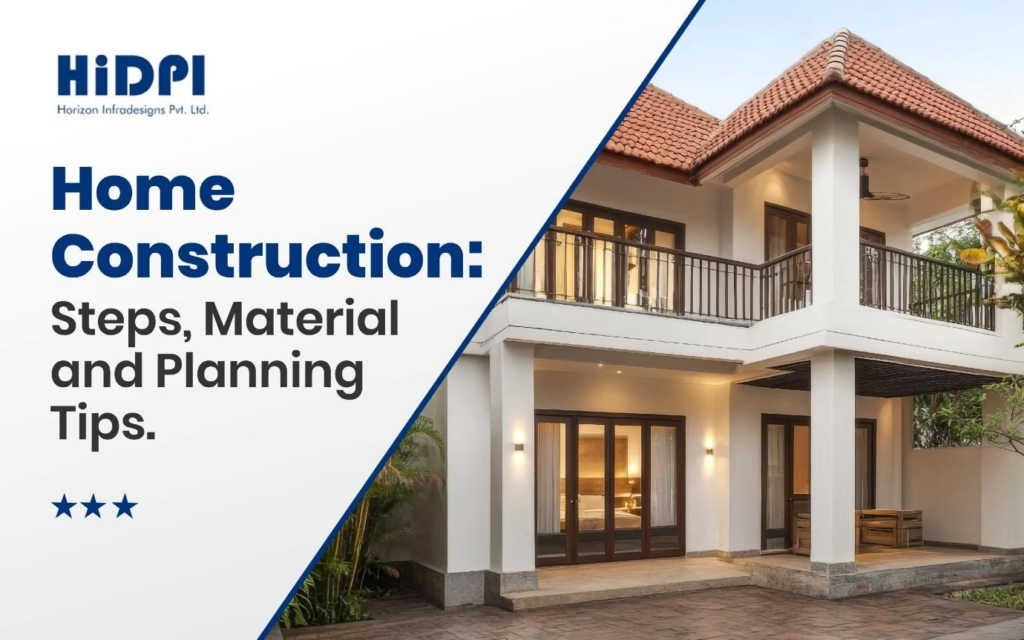Building your dream home is a major life milestone. It reflects your lifestyle, comfort preferences, and long-term vision. Whether it’s a compact home, a modern villa, or a luxury residence, the right home construction plan, high-quality home construction materials, and proper sequencing of home construction steps ensure a smooth and stress-free experience.
Here is a complete guide on how to plan, design, and build your dream home with clarity and confidence.
1. Start with a Clear Vision and Home Design
Every beautiful home starts with a strong concept. Think about:
- How many rooms you need
- The kind of layout that suits your lifestyle
- Your preferred architectural style
- Natural light and ventilation
- Long-term use and future expansion
A thoughtful home design ensures your home is functional, aesthetic, and easy to maintain. Working with a reliable construction company in Jaipur can help you convert your inspirations into a practical design that balances creativity with engineering accuracy.
2. Prepare a Well-Structured Home Construction Plan
A detailed home construction plan is essential for avoiding delays, extra expenses, or technical issues. A complete plan includes:
Architectural Layouts
Floor plans, elevations, room layout concepts, door–window placements, and space planning.
Structural Engineering Drawings
Beam–column placements, RCC details, load-bearing calculations, and reinforcement specifications.
Electrical & Plumbing Drawings
Lighting layouts, DB schedules, switchboard planning, water supply lines, drainage systems, and HVAC placements.
Budget & Timeline Planning
A realistic cost estimate and construction timeline help maintain transparency and ensure the project stays on track.
Many top EPC engineering companies in India follow this method to deliver well-organized residential projects with professional precision.
3. Follow the Correct Home Construction Steps
Home construction is a multi-stage process. Following the right order ensures smooth execution and structural stability.
Step 1: Land Survey & Soil Testing
Soil quality determines the type of foundation required. Before construction begins, the land must be tested by a certified soil testing lab to check bearing capacity, moisture levels, and soil composition. A detailed land survey ensures your structure follows legal boundaries, elevation guidelines, and zoning regulations.
Step 2: Foundation Work
This includes excavation, footing, and foundation RCC. A strong, well-designed foundation prevents settlement, cracks, and structural risks and ensures your home remains stable for decades.
Step 3: Structural Construction
Columns, beams, slabs, and brickwork take shape. This creates the structural framework or “skeleton” of your home, which defines its strength and durability.
Step 4: Roofing & Waterproofing
Proper waterproofing prevents leakage, seepage, and major structural wear over the years. A strong roof enhances weather resistance and safety.
Step 5: Electrical & Plumbing Setup
Concealed electrical wiring, piping, drainage systems, and water lines are installed during this stage. Good-quality materials prevent future repair issues and ensure safety.
Step 6: Flooring, Plastering & Interior Work
From tile installation to wall plaster, window frames, doors, and interior partitions, this stage transforms the structure into a livable space.
Step 7: Painting & Finishing
Interior paint, exterior coats, carpentry, modular elements, and fixtures complete the finishing touches, making your home aesthetically appealing and comfortable.
Step 8: Final Inspection & Handover
Thorough quality checks, safety inspections, and finishing reviews ensure everything is perfect before the house is officially handed over.
4. Choose the Right Home Construction Materials
Using the best home construction materials ensures durability, beauty, and low maintenance. Some essential material categories include:
• Cement & Steel
Choose high-quality cement and TMT bars for structural strength and earthquake resistance.
• Bricks & Blocks
AAC blocks, fly-ash bricks, and red clay bricks offer insulation, energy efficiency, and structural stability.
• Aggregates & Sand
Clean sand and quality aggregates ensure strong RCC and plastering work.
• Electrical & Plumbing Materials
Always choose branded pipes, switches, wires, and motors to avoid frequent repair work.
• Finishing Materials
Tiles, laminates, wooden flooring, paint, and fittings should balance beauty with durability.
Experienced builders, including a skilled construction company, guide homeowners in selecting the best materials based on climate, budget, and long-term value.
5. Smart Planning Tips to Build the Perfect Home
Maximize Natural Light & Ventilation
A well-lit home saves energy and feels more spacious and comfortable.
Plan for Future Needs
Include flexible rooms, extra storage, and external provisions for solar power or extensions.
Focus on Safety & Durability
Use fire-resistant wiring, anti-skid flooring, and quality waterproofing for long-term safety.
Allocate a Realistic Budget
Prioritize structural quality and electrical–plumbing work over decorative finishes.
Choose the Right Technical Partner
A reliable engineering team ensures quality, technical accuracy, and timely delivery.
Final Thoughts
Building your dream home is an exciting journey—one that requires planning, clarity, and expert execution. With the right home construction plan, high-quality home construction materials, and a structured approach to home construction steps, your dream home becomes a reality that lasts for generations.
With engineering excellence, transparent processes, and end-to-end project management, HIDPL ensures that every home is built with precision, safety, and elegance.






